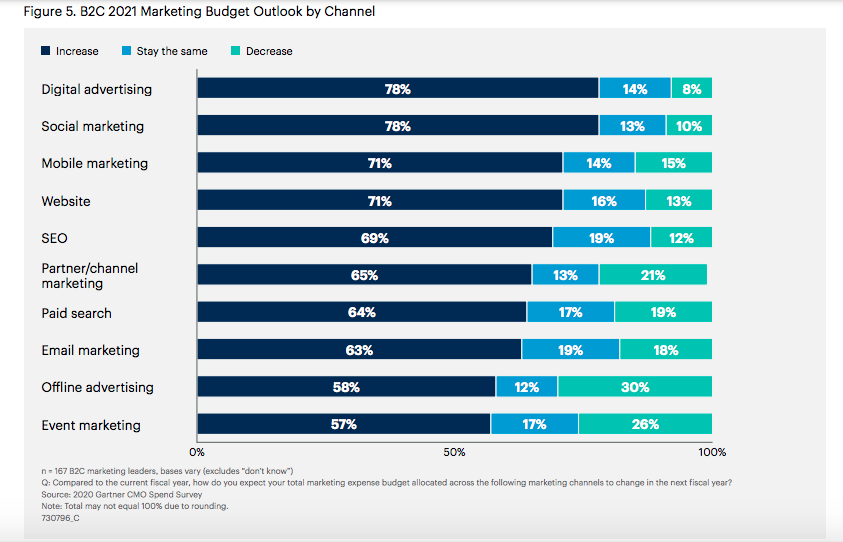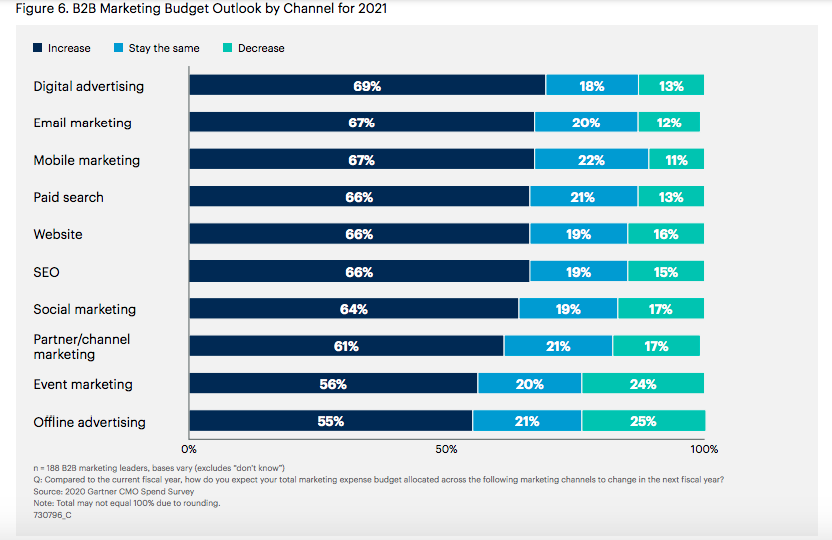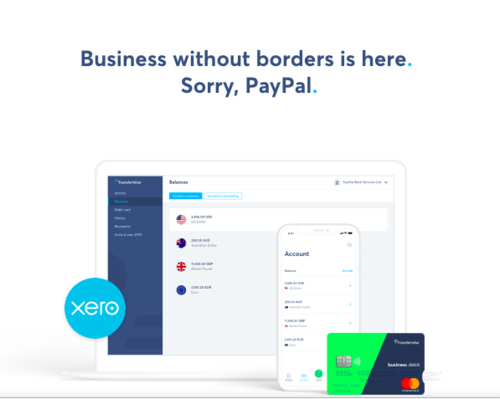This is the content.php article
Month: September 2021
This is the content.php article
This is the content.php article
This is the content.php article
Businesses of all sizes scrambled to reorganize their marketing budgets because of the turmoil caused by the 2020 global pandemic. CMOs, marketing directors, and small business owners adjusted their spending priorities in all categories, from technology to their hired contractors.
A recent report from Gartner cites that in 2020, 80% of budgets were allocated for digital channels as companies shifted away from in-person events.
Now, as we see signs pointing towards a slow but steady recovery across most industries, marketers are cautiously planning for growth. Let’s take a look at where marketers plan to invest their dollars online and off as we ease out of the pandemic.
Budgets Were Affected Across Most Sectors
Demand fell as the pandemic tightened its hold on almost every industry. Hospitality, travel, and retail suffered some of the biggest losses as consumers stayed home. For more traditionally stable sectors, many businesses enacted hiring freezes, layoffs, and furloughs.
Marketers and creative contractors also experienced significant losses. Over a third of businesses utilizing external agencies brought these services in-house to cut costs.
CMOs list these as the top services that they normally outsourced but shifted gears due to economic uncertainty:
– Social media marketing
– Creative Production/Content Marketing
– Video/Podcast/Photography Production
– Creative Concepting
Even though many businesses did this in 2020, not all experienced a positive benefit. Marketers were stretched to their limits as they were given heavier workloads and fewer resources.
Marketing Budgets Still Favor Technology
There was one sector that didn’t experience a downturn at all during the pandemic—marketing technology. As part of their marketing budget plan, over 70% of businesses expect to invest slightly to significantly more in customer data, mobile marketing, and digital commerce platforms.
But this breaks down further into digital and traditional marketing channels as the recovery continues.
Digital Advertising
Companies spent over a quarter of their budgets on this channel. There’s no sign of this slowing down as they increase their spending for display and video ads on platforms like Amazon and YouTube.
Owned Channels
At the beginning of the pandemic, people flocked online to get news updates and connect with friends and family. As a result, businesses concentrated—and spent almost 60% of their budgets—on social marketing, SEO, and mobile.
Event Advertising
In the past year, most events were either canceled, postponed, or completely moved online. Normally, face to face events get a smaller share of the pie, with less than 10% of marketers allocating their budgets towards it. However, marketers are optimistic about what relaxed restrictions and the widespread use of vaccines will mean for in-person conferences and events.
Optimism About the Future
For B2C marketers, they’re feeling incredibly excited about what’s to come. The current data shows that e-commerce is about to experience a boom, which may, unfortunately, hit brick-and-mortar retailers in their pocketbooks.

Analysts predict that online purchases from new and moderate shoppers will increase by 169% after the pandemic is over. Much of this is attributed to consumers turning towards home delivery, curbside pickup, and online storefronts.
Businesses are ready to capitalize on this stat as B2C marketers intend to invest more of their budgets in digital advertising and paid search.

On the flip side, B2B marketers remain cautious and anticipate a slower recovery as different sectors rebound from the past year. But for those who are prepared to pour money into their marketing budgets, email and paid search will take up a big portion of it.
Smaller Companies Play it Safe
Small businesses were hit especially hard in 2020, and many were quick to reduce their marketing budgets like their larger, corporate cousins. But social media continued to be a revenue driver for the small businesses. Over 40% of local businesses depended on social media to get the message out about their services.
As word spread online about restaurants and local businesses struggling to keep their doors open, social proved to be a sound investment.
But it’s unclear how much smaller companies will increase their budgets post-pandemic as 47% of them spend less than $10,000 on digital marketing. However, it is known that the small percentage of companies spending more than this will invest in technology, data, and other digital initiatives.
Preparing for a Resurgence
We’ve all had to change how we communicate not only as individuals but as businesses. Moving forward, companies have to figure out which channels make sense to invest in and which technology and people to utlize.
We’re optimistic that those who survived the economic impact of the pandemic will continue building better businesses while strengthening relationships with their customers.
This is the content.php article
This is the content.php article
How memorable is your brand? In all honesty, most companies struggle to reach the pinnacle of brand recognition, where customers have a full picture of what a business stands for.
For those that make it, people naturally associate the brand with an immediate—hopefully, positive—image. This association leads to more brand loyalty and higher revenue. But before this happens, you must climb the different rungs of the branding ladder to move from unknown to unforgettable.
Rung 1: Unbranded
From Day One, unless you’re very lucky, the company will be relatively unknown. Customers may have been introduced to your business but generally have no idea what it represents—or even remember what your logo looks like.
Heck, you might be still trying to figure it out yourself.
At this stage, you have the luxury of being flexible. Each day is a new opportunity to mold the company’s message and develop your brand’s essentials.
For startups that, by their very nature, work at lightspeed, decisions about brand elements are usually made on the fly. As the company matures, it’ll need to be solidified as you begin creating a cohesive brand.
Rung 2: Recognition
Now at this point, you would have some visually branded assets, at the very least a logo, website, and a few social media profiles. People are beginning to notice and recognize your business. They’ve seen your products, and many have even bought a few.
But your products are not the same as the brand.
People are not yet building an immediate association with your brand’s image, messaging, and values.
And here’s where it gets sticky.
Many businesses encounter a common problem as they try to climb the next rung. It’s usually difficult for stakeholders and managers to look at their strengths and weaknesses objectively. If they don’t fully understand where their brand stands, it’s not easy to continue moving forward from vague recognition to a distinctive brand.
Rung 3: Positioning
A major advantage of brand positioning is hollowing out a solid place of your own in the industry. You’re using data and consumer insights to direct your marketing efforts, but it’s not without its challenges. According to Bynder’s State of Branding Report, one of the top struggles marketers encounter at this level is how to “make sense of inaccurate or inconsistent data.”
This news might sound like doom and gloom, but this is the breakthrough stage for your brand, and more importantly, it’s where you build your tribe.
But to do it, you have to keep working towards creating more creative content and use consumer insights to position your business as an industry leader.
Rung 4: Personality
The most memorable brands create a cult of personality that customers want to be part of. Starbucks’ culture centers around building coffee bars that give people a similar experience as what they would find in Italy.
People want to become part of the company’s brand and often integrate it into their own identities. Diehard Starbucks fans, for instance, visit the café at least 18 times a month, spending around $3.50 each time. They’re loyal fans of the brand who don’t just love it but live it.
Once a corporate branding design is fully fleshed out, you’re in a place where people hear your company’s name and can instantly visualize it. Think of Apple. When this name is mentioned, people know it evokes images of sleek devices, sophisticated branding, and minimalist features.
Google is another example of business branding filled with personality. As the world’s largest search engine, Google’s colorful font logo, iconography, and, of course, daily doodle are all familiar elements of a brand, which has a strong presence in our lives.
Rung 5: View of the World
Once you’ve gotten to this rung, your brand has not only a personality but uses effective branding strategies to express what the company believes in.
Online banking service Wise is an international company focused on creating internal and external policies promoting transparency and inclusivity in digital finance.
They’ve built their business around customer feedback and use their experiences to deliver better financial products and services. Wise understands that the current way businesses function online and off requires modern solutions.
In the company’s view, banking should be accessible to everyone. And they’re also not shy about throwing shade at competitors who actively limit their customer’s ability to do business online.

The takeaway is that brand storytelling, and core beliefs aren’t about numbers. It’s about the company’s emotional and societal impact it makes on its customers and the world.
Rung 6: Company and Policy
If your company makes it to the top of the ladder, it has everything it needs to be a memorable brand that customers love and trust. But building fair customer service and employee policies into the company is how you create a lifelong, supportive following.
It’s been shown that people will spend more with companies providing a good customer experience. Part of that includes showing that your employees—and company—care about making things right when there’s a wrong and making an effort to treat them with respect.
Conclusion
If you think your company is on the lower rung right now, it doesn’t have to stay that way. There’s always a way to keep climbing to increase your brand’s resonance with customers.
But remember, the inverse is also true.
Once you reach the top of the ladder, the brand still needs to be refined to stay relevant. Otherwise, you’re risking being knocked down a peg or two.


